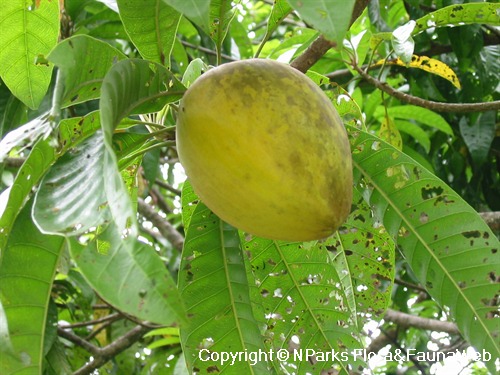
Back
Pouteria campechiana Kunth (Baehni)
| Family Name: | Sapotaceae |
| Synonyms: | Pouteria lucuma, Lucuma nervosa, Achras lucuma |
| Common Name: | Eggfruit Tree, Canistel, Amarillo, Yellow Sapote, Sapote Borracho, Zapote |
Name
Classifications and Characteristics
| Plant Division | Angiosperms (Flowering Seed Plants) (Dicotyledon) |
|---|---|
| Plant Growth Form | Tree (Medium (16m-30m)) |
| Lifespan (in Singapore) | Perennial |
| Mode of Nutrition | Autotrophic |
| Plant Shape | Broad / Mushroom / Hemispherical |
| Maximum Height | 30 m |
Biogeography
| Native Distribution | Mexico, Central America |
|---|---|
| Preferred Climate Zone | Tropical, Sub-Tropical / Monsoonal |
Description and Ethnobotany
| Others - Plant Morphology | Growth Form:Erect slender tree with a spreading form, generally not more than 8 m tall, but able to reach a height of 30 m in optimal growing conditions. Habitat:Found at elevations below 1400 m, P. campechiana grows in a tropical or sub-tropical climate. Mainly a cultivated plant grown commercially, it has been reported to become naturalised in places like the Florida Keys, the Bahamas and Cuba, although it is also thought that these may be plants growing on former homesteads. P. campechiana is known to occur naturally only in southern Mexico. Stem:Trunk diameter may reach up to 1 m. Bark brown, furrowed with abundant white gummy latex. Young branches are velvety brown. Foliage:Leaves evergreen. Alternate, though mostly grouped at branch tips, leaves are thin, glossy and petiolate. Leaf shape ranges from oblanceolate, lanceolate-oblong to obovate. Leaf apices are bluntly pointed while leaf bases are sharply tapered. Flowers:Flowers bisexual, solitary or in small clusters and fragrant. Borne at leaf axils or leafless nodes, the flowers are 5- or 6-lobed, cream-coloured, silky-hairy and about 8-11 mm long. Fruits:Fruits variable in shape, from nearly round to somewhat ovoid, oval or spindle-shaped, with or without a pointed apex or curved beak. Often bulged on one side, the fruit has a 5-point calyx at the base, which may be rounded or have a distinct depression. Size about 7.5-12.5 cm long and 5-7.5 cm wide. When unripe, the fruit is green, hard and gummy inside, going on to turn lemon-yellow, golden-yellow or orange-yellow on ripening with a smooth and glossy skin sometimes with light-brown to reddish-brown roughed patches.Flesh is yellow, firm and pasty, becoming softer towards the seeds, resembling the texture of the yolk of a hard-boiled egg or to some, the flesh of pumpkin.Seeds 1-4, hard and free-stoned, near-oval to oblong-oval, glossy and chestnut brown, except for the straight or curved ventral end, which is dull light-brown to greyish-white. Both tips of the seed are sharp. Cultivation and landscaping:While maintenance of P. campechiana is relatively low, it is beneficial to carry out mulching in the early years of the plant, as well as the application of fertiliser at the time of planting and during periods of rapid growth. Although wind-resistant and suitable for windy locations, pruning may be carried out to avoid damage by wind as well as to shape the crown, which provides considerable shade when the tree is mature. Suitable for planting in home gardens. Food:The fruit is eaten with condiments, including salt and pepper, with fresh or after light baking. The flesh may be pureed and used in custards, ice creams and other confectionaries. May also be used in eggnog recipes to make a special "eggfruit nog". The fruit can also be dehydrated and reduced to a nutritional powder, which has become available as a commercial product. While edible, it is not juicy or crispy like many other fruits, and hence not highly regarded. However, studies have shown the fruit to be rich in niacin and carotene and contain a fair level of ascorbic acid. Chemical analyses have also shown it to be more nutritious than the carambola (Averrhoa carambola), except in moisture, fibre and riboflavin content. Medicine:A decoction of the astringent bark is known to be used in Mexico to reduce fevers, as well as to treat skin conditions. Seeds are used in treatment against ulcers. Timber:The wood of P. campechiana is valued for being fine-grained, compact, strong and moderate to very heavy and hard, especially suitable for planks and rafters in construction. The heartwood is greyish-brown to reddish-brown, blending into the somewhat lighted-coloured sapwood. The darker the colour of the wood, the more resistant to decay. |
|---|---|
| Ethnobotanical Uses | Edible Plant Parts : Edible Fruits Food (Fruit or Vegetable) (Herb or Spice) |
Landscaping Features
| Desirable Plant Features | Fragrant (Flowers) (Day) |
|---|---|
| Landscape Uses | Container Planting, General, Shade Providing Tree / Palm, Focal Plant |
| Plant & Rootzone Preference or Tolerance Remarks | Can be cultivated in soils too thin and poor for other fruits trees. |
Fauna, Pollination and Dispersal
| Pollination Method(s) | Abiotic (Self-Pollinated), Biotic (Fauna) |
|---|
Plant Care and Propagation
| Light Preference | Full Sun |
|---|---|
| Water Preference | Moderate Water |
| Plant Growth Rate | Moderate |
| Rootzone Tolerance | Fertile Loamy Soils, Well-Drained Soils, Acidic (low pH) Soils |
| Maintenance Requirements | Low |
| Propagation Method | Seed, Stem Cutting, Grafting, Air-Layering |
Foliar
| Mature Foliage Colour(s) | Green |
|---|---|
| Mature Foliage Texture(s) | Glossy / Shiny |
| Foliar Type | Simple / Unifoliate |
| Foliar Arrangement Along Stem | Alternate |
| Foliar Shape(s) | Non-Palm Foliage (Obovate, Lanceolate, Oblong) |
| Foliar Margin | Entire |
| Foliar Base | Acute |
| Leaf Area Index (LAI) for Green Plot Ratio | 3.0 (Tree - Intermediate Canopy) |
Non - Foliar and Storage
| Trunk Type (Non Palm) | Woody |
|---|---|
| Mature Bark Texture | Fissured |
Floral (Angiosperm)
| Flower & Plant Sexuality | Bisexual Flowers |
| Flower Colour(s) | Cream / Off-White |
|---|
Fruit, Seed and Spore
| Mature Fruit Colour(s) | Orange, Yellow / Golden |
|---|---|
| Fruit Type | Fleshy Fruit |
Image Repository
Others
| Master ID | 1793 |
|---|---|
| Species ID | 3086 |
| Flora Disclaimer | The information in this website has been compiled from reliable sources, such as reference works on medicinal plants. It is not a substitute for medical advice or treatment and NParks does not purport to provide any medical advice. Readers should always consult his/her physician before using or consuming a plant for medicinal purposes. |

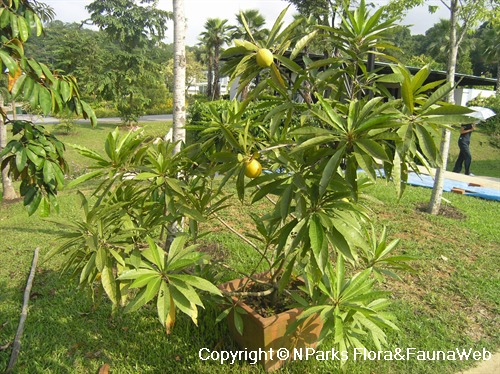
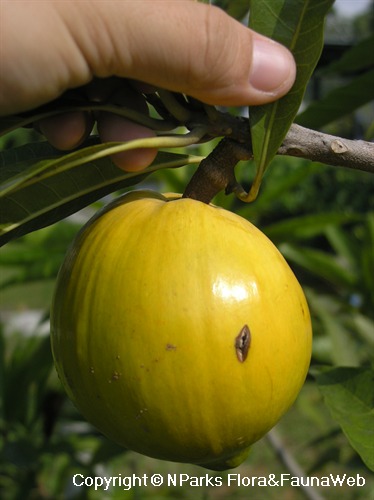
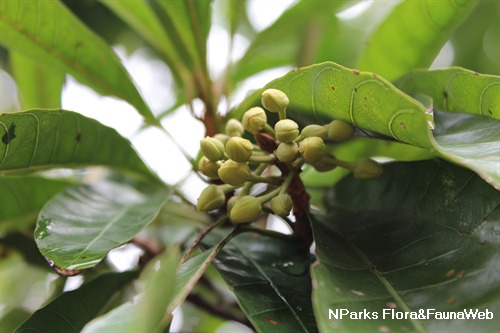
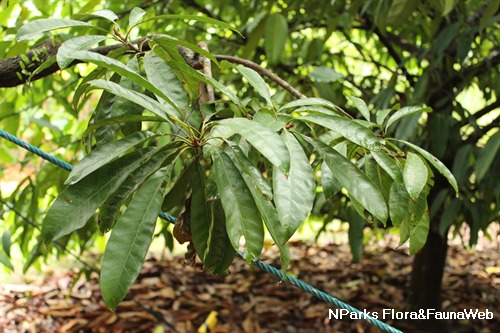
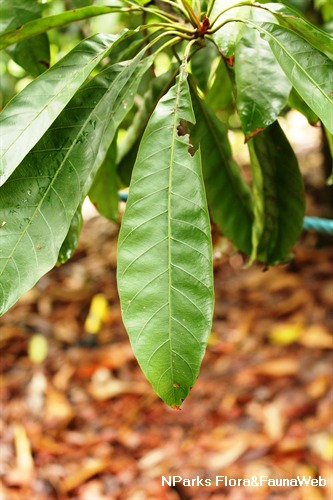
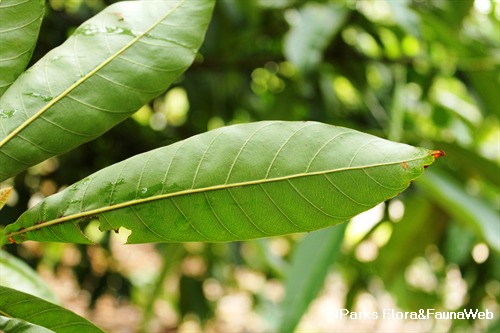
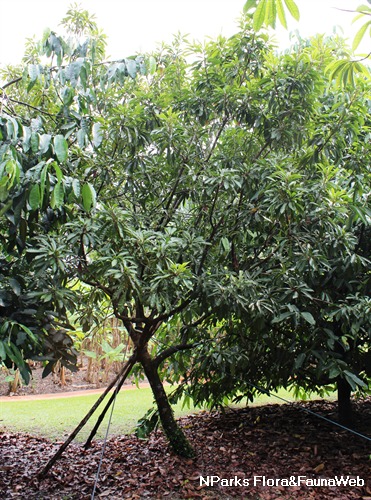
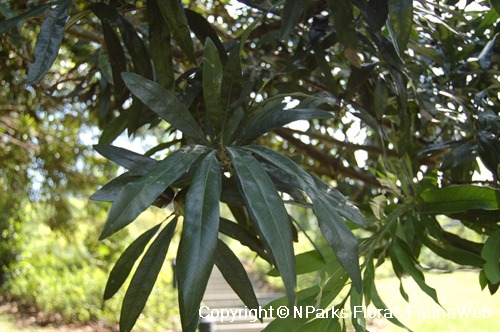
.jpg)